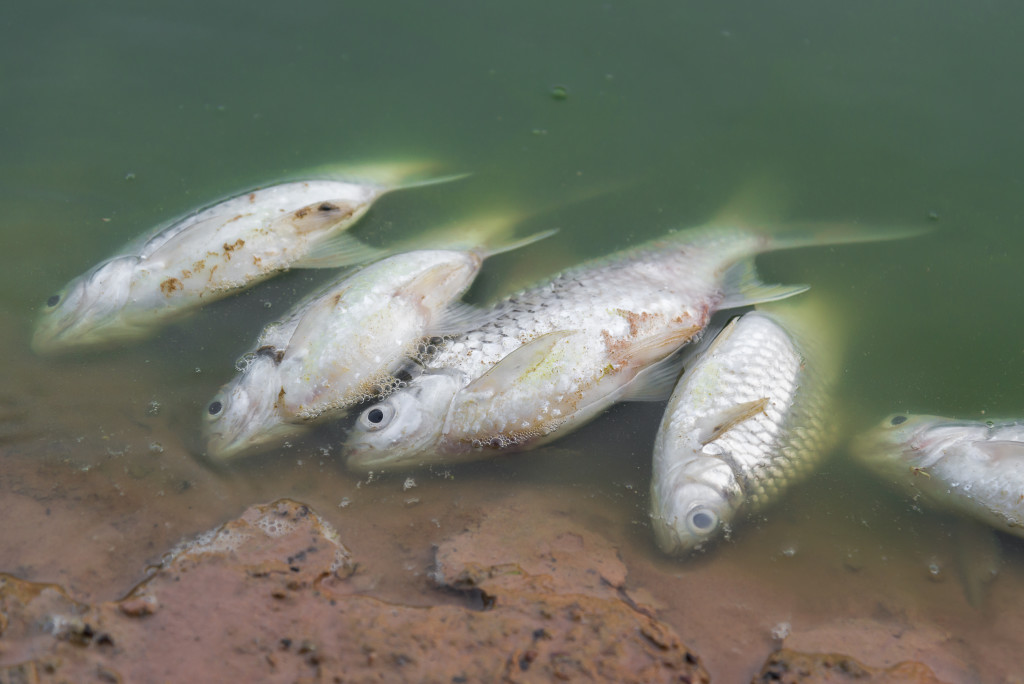Today, industrial or intensive farming dominates U.S. livestock production. Nearly all the meat, poultry and dairy products consumed in the U.S. come from industrial-scale operations where thousands of cattle, tens of thousands of pigs and hundreds of thousands of chickens are kept in closely confined conditions, indoors or on dirt lots.
But when you confine large numbers of animals in one place, you also have to deal with the huge volumes of excrement they produce. Research shows that U.S. industrial livestock farms produce up to 1.37 billion tons of manure each year—that’s 20 times more fecal waste than the entire U.S. human population! This poses serious pollution risks to water resources and the air around us.
Water Pollution

Industrial agriculture is the leading contributor of pollutants to lakes, rivers and reservoirs in the U.S. According to the U.S. Environmental Protection Agency (EPA), many states with high concentrations of large industrial livestock operations experience 20 to 30 serious water quality problems a year as a result of manure management problems.
Whether we’re talking cattle, hogs or poultry, industrial livestock operations produce vast quantities of concentrated waste–a toxic concoction of feces, heavy metals, antibiotic and other drug residues, growth hormones, animal blood and harmful bacteria such as E. coli. Even moderately intensive livestock operations can produce as much manure as a small sized city: a 2,500-head dairy cattle operation, for example, can produce as much waste as 61,000 people. However, there are two important differences. First, livestock wastes can be up to 100 times more concentrated than human wastes; second, human waste must be treated before it is discharged into the environment.
Most industrial livestock operations pump the toxic liquid waste output into vast open containment tanks or lagoons (as in the Georgia hog operation at the top of this page). Some of these lagoons are as big as several football fields (zoom in on this Google Map of two relatively small intensive hog operation in North Carolina for an idea of the scale).
One of the cheapest–and therefore most common–disposal methods is to periodically spray the liquid waste on surrounding fields. The problem is the waste is often sprayed at such high application rates—or so frequently—that the soil and plants cannot absorb it, let alone utilize it. This over-application leads to toxic run-off, where water-soluble nutrients and other contaminants find their way into waterways and groundwater systems, polluting our drinking water and rivers. Leaks or breaks in storage or containment units, as well as accidents and storm floods, can also result in massive releases of the toxic waste into our waterways. Researchers state that, based on available data, “generally accepted livestock waste management practices do not adequately or effectively protect water resources from contamination with excessive nutrients, microbial pathogens, and pharmaceuticals present in the waste.”
Water tests also reveal other contamination, including hormones in surface waters around industrial livestock farms where hormones are routinely used to promote animal growth or productivity. Research shows these hormones can alter the reproductive habits of aquatic species, affecting the fertility of female fish and other species.
The threat to our water supplies from industrial livestock farming is not limited to toxic manure effluent. Vast quantities of fertilizer are used to grow millions of acres of grain crops for livestock feed. Combined with the toxic manure effluent, fertilizer runoff from intensive grain production is directly contributing to the 230 recognized oxygen-deprived Dead Zones along the U.S. coast where almost no life exists beneath the water, such as in Chesapeake Bay and the Gulf of Mexico. In 2014, the Gulf Dead Zone measured 5,052 square miles–more than twice the size of the state of Delaware.
Air Pollution

The pollution risks from industrial farming systems are not limited to surface and groundwater. The storage of waste effluent in open lagoons, and its frequent spreading on nearby fields, can result in significant air emissions, including toxic gases and particulate dust.
Exposed to the elements, the waste lagoons emit toxic gases such as ammonia and hydrogen sulfide, as well as methane and nitrous oxide—key greenhouse gases (see our section on CLIMATE CHANGE). Industrial operations that keep animals on dirt feedlots are also responsible for the production of significant quantities of harmful particulates, comprising of dried feces and urine, feed and bedding material, as well as bacteria and pharmaceutical residues (see our section on HUMAN HEALTH). All can significantly affect the air quality in areas near industrial farms, leading to environmental and human health problems.
TAKE POSITIVE ACTION
At AGW, we know that well-managed pasture-based farming systems do not result in the same environmental pollution risks to water or air as industrial livestock farms do. In pasture-based systems, livestock urine and feces are not pumped into vast open-air lagoons and disposed of in high concentrations. Instead, manure is either naturally deposited as the livestock are grazed or moved across the land, or stored carefully over the winter period for targeted spreading as a valuable natural fertilizer at appropriate periods later in the year.
Next:
Industrial farming is a major contributor to climate change…
Be part of the solution:
Find out how your daily food choices can help fix our broken food system here!
